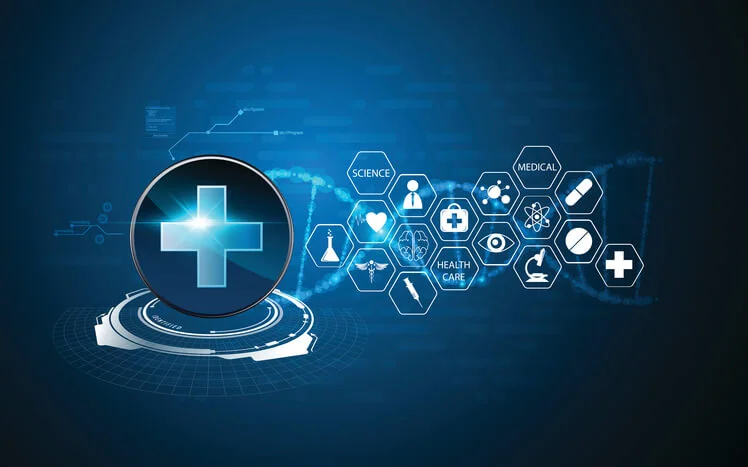Introduction: A Paradigm Shift in Personal Health Management
The world is witnessing a healthcare revolution driven by digital innovation. As technology increasingly permeates daily life, digital health platforms and smart devices are emerging as vital tools for managing personal well-being. These technologies, ranging from wearable fitness trackers and AI-powered health apps to cloud-based patient portals and remote monitoring systems, are transforming how individuals engage with their health.
This transformation is not only empowering patients with real-time insights into their well-being but also enhancing the effectiveness of preventive care, chronic disease management, and healthcare accessibility. Digital health platforms and smart devices now form a rapidly evolving ecosystem that is reshaping the doctor-patient relationship, healthcare delivery, and even the economics of health systems globally.
This article explores the landscape of digital health, the evolution and integration of smart health devices, the benefits and challenges associated with these innovations, and the role they will play in the future of health management.
1. The Rise of Digital Health: Definitions and Ecosystem
1.1 What Is Digital Health?
Digital health encompasses the use of digital technologies to enhance healthcare delivery, improve personal health monitoring, and support clinical decision-making. This broad field includes:
- Mobile health apps (mHealth)
- Electronic health records (EHRs)
- Telemedicine and virtual care
- Artificial intelligence (AI) in diagnostics
- Health information technology (HIT)
- Wearable and implantable health devices
Together, these tools create a connected health ecosystem that bridges gaps between patients, providers, and health systems.
1.2 The Digital Health Ecosystem
The digital health ecosystem can be divided into three layers:
- Consumer-facing technologies – Wearables, health apps, telehealth platforms.
- Provider-side platforms – EHRs, clinical decision support systems (CDSS), remote diagnostics.
- Data and analytics infrastructure – AI algorithms, cloud-based data platforms, and health informatics tools.
2. Smart Devices: The New Health Companions
2.1 Wearables and Health Trackers
Wearable devices such as smartwatches, fitness bands, and biosensors are among the most widely adopted smart health tools. They monitor metrics like:
- Heart rate
- Blood oxygen saturation (SpO2)
- Sleep patterns
- Blood pressure
- ECG (electrocardiogram)
- Stress levels
- Physical activity and calorie expenditure
Devices like the Apple Watch, Fitbit, Garmin, and WHOOP have become mainstream, enabling users to track their daily vitals and receive alerts for abnormal readings.
2.2 Medical-Grade Devices for Home Use
Beyond consumer-grade wearables, the market is also seeing a rise in clinically validated smart devices for remote patient monitoring (RPM), such as:
- Smart glucometers for diabetics
- Smart inhalers for asthma and COPD
- Bluetooth-enabled blood pressure monitors
- Portable ECG monitors
These tools allow patients with chronic conditions to manage their health from home, minimizing hospital visits and enabling real-time data sharing with healthcare providers.
2.3 Implantables and Biosensors
Emerging technologies are pushing boundaries with implantable devices and ingestible sensors. Examples include:
- Continuous glucose monitors (CGMs)
- Cardiac implants that transmit data to cloud servers
- Smart pills that track medication adherence
These devices ensure continuous health monitoring with minimal patient intervention.
3. Digital Health Platforms: Connecting Data, Patients, and Providers
Digital health platforms act as the central hub for collecting, analyzing, and sharing health data. Their functions include:
- Health data integration from multiple sources (EHRs, wearables, labs)
- AI-powered analytics for early detection and personalized treatment
- Telehealth integration for remote consultations
- Care coordination among providers, patients, and caregivers
- Secure patient portals for accessing medical records and prescriptions
Examples of leading platforms:
- Apple Health and Google Fit
- MyChart (Epic Systems)
- Teladoc and Amwell (telehealth services)
- Validic and HealthKit (data integration platforms)
4. Benefits of Digital Health Tools in Daily Management
4.1 Empowerment and Engagement
One of the most significant impacts of digital health tools is patient empowerment. Users gain real-time insights into their health and can:
- Track progress toward fitness goals
- Monitor symptoms
- Identify early warning signs
- Manage medications
- Take a proactive approach to wellness
Studies show that engaged patients are more likely to adhere to treatment plans and make informed lifestyle choices.
4.2 Personalized and Preventive Care
Digital health platforms support precision medicine by integrating genomics, lifestyle data, and biometric metrics. This allows providers to:
- Tailor treatments based on individual profiles
- Prevent exacerbations of chronic diseases
- Detect conditions early through continuous monitoring
For instance, predictive algorithms can alert a heart failure patient of fluid retention before symptoms worsen.
4.3 Remote Access and Healthcare Equity
Telehealth and remote monitoring tools enhance healthcare accessibility, especially for:
- Rural populations
- Elderly and immobile patients
- Those with limited access to specialists
Digital tools reduce the dependency on physical visits and eliminate geographical barriers.
4.4 Real-Time Decision Support
Smart devices integrated with AI offer real-time decision support for patients and clinicians alike. Examples include:
- Medication reminders
- Early detection of arrhythmias
- Fall detection alerts for the elderly
- AI chatbots for triaging symptoms

5. Challenges and Risks in Digital Health Adoption
Despite their potential, digital health platforms and smart devices face several challenges:
5.1 Data Privacy and Security
The collection and transmission of sensitive health data raise serious concerns about:
- Cybersecurity threats
- HIPAA/GDPR compliance
- Unauthorized third-party access
Companies must ensure end-to-end encryption, secure cloud storage, and transparent privacy policies.
5.2 Data Overload and Fragmentation
The abundance of health data from various sources can be overwhelming. Without proper integration and analysis:
- Clinicians may struggle to interpret data effectively
- Patients might misinterpret health metrics
- Systems may become siloed and inefficient
Interoperability and standardization (e.g., FHIR, HL7) are crucial to addressing these issues.
5.3 Digital Literacy and Accessibility
Not all populations have equal access to or understanding of digital tools. Barriers include:
- Low digital literacy
- Lack of internet access
- Economic constraints
- Age-related limitations
Bridging this digital divide is essential for equitable healthcare.
5.4 Clinical Validation and Regulation
Not all health apps and devices undergo rigorous clinical testing. Regulatory bodies like the FDA and EMA are working to classify and approve digital health tools, but the field is evolving rapidly. Ensuring safety and efficacy is a continuing concern.
6. Integration with Healthcare Systems
For digital health tools to be truly effective, they must integrate seamlessly into existing healthcare systems. This involves:
- EMR/EHR compatibility
- Reimbursement models for digital care
- Provider training and workflows
- Value-based care alignment
Payers and providers must also recognize digital health as a legitimate mode of delivering and managing care to ensure long-term adoption.
7. The Future Outlook: Where We’re Headed
7.1 AI-Powered Predictive Health
The future lies in predictive and preventive health management powered by AI. Combining genomics, lifestyle, and biometric data, AI can:
- Predict the onset of diseases before symptoms appear
- Optimize treatment paths
- Reduce healthcare costs by avoiding complications
7.2 Interconnected Health Ecosystems
Soon, individuals will interact with fully integrated health ecosystems, where:
- Smart homes adjust lighting or temperature based on health conditions
- Wearables sync with dietary apps and medication schedules
- Virtual health coaches guide fitness, sleep, and stress
Such ecosystems will promote continuous, holistic health management.
7.3 Blockchain for Health Data Management
Blockchain offers potential solutions for secure, decentralized health data ownership, enabling patients to:
- Control who accesses their data
- Ensure immutable health records
- Prevent data tampering
This could revolutionize trust in digital health systems.
Conclusion: A Healthier, Smarter Future
Digital health platforms and smart devices are no longer futuristic concepts—they are already transforming how individuals manage their health on a daily basis. From wearable sensors that track vital signs to AI-driven platforms offering personalized insights, these tools are reshaping the landscape of modern healthcare.
Despite challenges related to data privacy, integration, and digital literacy, the potential of digital health to enhance quality of life, empower individuals, and reduce healthcare costs is undeniable. As technology continues to evolve and integrate with healthcare systems, digital health will become an indispensable pillar of proactive, preventive, and patient-centered care.
The future of health is not just in hospitals—it’s in our homes, wrists, phones, and clouds.












































